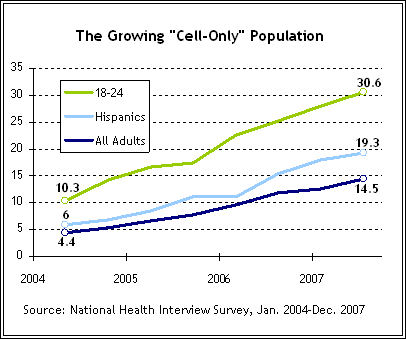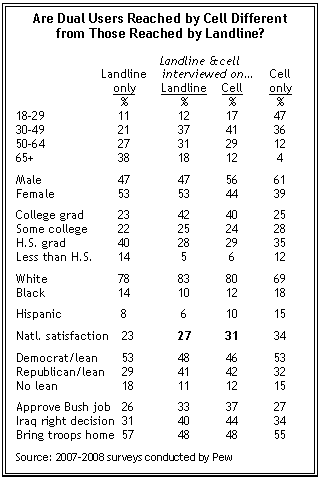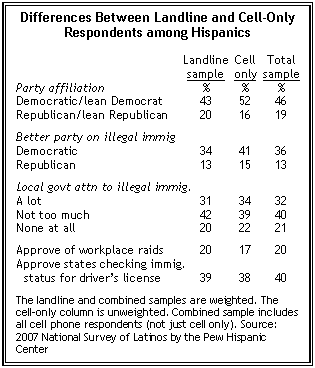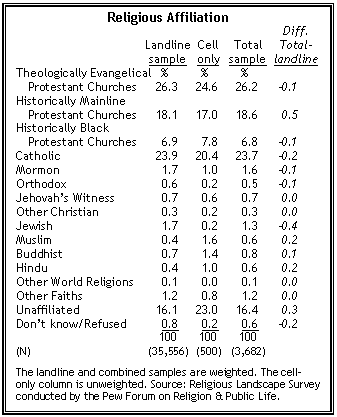by Scott Keeter, Director of Survey Research, Pew Research Center
Last week the National Center for Health Statistics released new government estimates of the number of Americans who can now be reached only by a cell phone — an estimated 14.5% of all adults, and significantly larger percentages in certain population subgroups such as young people and Hispanics. The growing number of wireless-only households poses a serious challenge to survey research, much of which relies upon landline surveys to reach respondents.

The Pew Research Center has been tracking and studying the cell phone challenge for several years, and reported its latest research on the issue at the annual meeting of the American Association for Public Opinion Research (AAPOR), held in New Orleans May 15-18.
Researchers from Pew presented four papers dealing with cell phone issues. One reported on the so-called “dual users” — people who have both landline and cell phone service and theoretically can be reached either way. Another paper focused on the 2007 National Survey of Latinos, which included landline and cell phone interviews. A third described the religious affiliation of the cell-only population. And a fourth reported on findings about internet use among the cell phone population. Here are some of the key findings, along with links to the full papers.
Most “dual users,” i.e. people living in households with both landlines and cell phones, are not functionally the equivalent of the cell-only population in that they use both their landlines and cell-phones relatively frequently.

Researchers for the Pew Research Center for the People & the Press found that dual users reached by cell phone are demographically and behaviorally similar to those reached by landline on most questions. They reported on a compilation of data from several dual-frame surveys in which the “dual users” reached in each frame could be compared. Small differences were seen on gender, age, and race, but on most other demographic questions the dual users reached in each frame were very similar. And, notably, key political variables such as party affiliation and ideology differ very little for dual users regardless of how they were reached.
An additional finding on the dual users was that a majority of dual users reached in each sampling frame said that they could have been reached at that moment on their other telephone. Even among cell phone respondents who said they get most of their calls by cell phone, nearly half said they could have been reached right then on their landline. These results strongly suggest that the “functionally cell-only” among the dual users constitute a relatively small proportion of the total.
The People-Press paper, “Costs And Benefits of Full Dual-Frame Telephone Survey Designs,” was co-authored by Scott Keeter, Michael Dimock, Courtney Kennedy, Jonathan Best, and John Horrigan.
The cost of cell-phone surveys has declined substantially.
Another important conclusion of the People-Press paper was that the cost of conducting cell phone interviews is now lower than it was in previous years, making it more feasible to include cell phones on a regular basis. Pew now estimates that the cost of adding a cell phone component to a survey is roughly twice the cost of the landline component on a per-interview basis, rather than three times as much in previous dual frame surveys.
One area in which a potential coverage bias may occur is in the use of, and attitudes toward, technology, especially among younger Americans.
A paper by researchers at Princeton Survey Research Associates International and the Pew Internet & American Life Project found that younger cell phone respondents were significantly more likely to say that they got news online than were landline respondents, even when comparing those who were internet users in both samples. The People-Press paper also found several significant differences between landline samples and blended samples on technology attitudes.
The PSRA/Pew Internet paper, “Internet Access and Use: Does Cell Phone Interviewing Make a Difference,” was written by Evans Witt, Jonathan Best, and Lee Rainie.
A major dual-frame study of the U.S. Latino population found many of the same patterns as dual-frame general population studies.

The Pew Hispanic Center’s 2007 National Survey of Latinos included 1,101 landline interviews and 899 cell-phone interviews. As in dual frame general public surveys, researchers from ICR and Pew reported that blended samples combining landline and cell phone respondents produce nearly identical results to those obtained solely from landline samples. This was true despite the fact that cell-only Hispanic respondents were much younger than landline respondents and much more likely to be acculturated.
One of the largest differences between the landline sample and the blended sample was on party affiliation. The percentage of Democratic and Democratic-leaning respondents was considerably higher in the cell-only sample than in the landline sample (52% vs. 43%). The blended total sample was 46% Democratic as opposed to 43% in the weighted landline sample.
Cell-only respondents were also more likely to say that they had ever been discriminated against in restaurants or stores, government offices, or by other people. On other questions, the differences between the landline and cell-only respondents were smaller.
But on almost all variables, the blended and weighted combined sample was little different from the landline sample alone.
The paper, entitled “Dual Frame (Landline and Cell RDD) Estimation in a National Survey of Latinos,” was written by David Dutwin, Courtney Kennedy, Scott Keeter, and Dale Kulp.
Cell-phone only respondents are more likely to be religiously unaffiliated than landline respondents, but properly weighted landline surveys correct for this potential bias.

The Pew Forum on Religion & Public Life’s Religious Landscape Survey included interviews with 500 cell-only respondents and found that the cell-only were different from landline respondents on some religious measures. They included a higher percentage of respondents who did not identify with any religious tradition, were less likely to be regular churchgoers, and were less likely to say religion was very important in their lives.
But much of this difference was a result of the younger average age of the cell-only respondents. When the cell phone and landline cases were combined and weighted to match demographic parameters for age, sex, race, education and region, the overall estimates for each of these religious measures were unchanged from what would be obtained using a landline sample alone.
The Pew Forum paper presented at the AAPOR conference, “Religion and the Cell-Only Population,” was co-authored by Allison Pond, Dan Cox and Gregory Smith.


